TECHNICAL RESILIENCE:
A FIT FOR PURPOSE FRAMEWORK FOR A DECADE
—It’s about time in Curriculum Design,
to create a new time-resilient condition.
Tikvah Breimer (MSc MAEd MSc),
Independent senior advisor, teacher trainer, director.

“How can I integrate a resilient approach to teaching in these times?
A surprising answer was provided by StudioBlended. Tikvah coached me in making my educational approach and impact last longer.
I realized that acquiring knowledge is a process that obeys the rules of resilience very strongly.”
Dr. Alexander Jachnow, Urban Researcher and Strategist
Institute for Housing and Urban Development Studies (IHS), Erasmus University, Rotterdam


“It was unexpected. (...) Instead of themes we would have grouped in a very concrete manner, it was all much more layered and strategic. Much more academic than I expected - for the good. We identified undercurrents, hypes and baselines and all in all created much more depth.
It was really useful to look at our program like this - the graphical output we received, shows rising and declining lines that require attention - which words/concepts are we going to use, and which aspects do we need to adjust in the background? Merely producing some themes with the team would have been irrelevant to me - what we did now, truly gets us further in the coming year as we reimagine the program. I got what i needed.”
Dr. Stefan van der Spek
Associate Professor of Urban Design at TU/Delft Faculty of Architecture and Built Environment, Program Director of MSc MADE at AMS Institute and co-director of VR-BK at BK-LABS
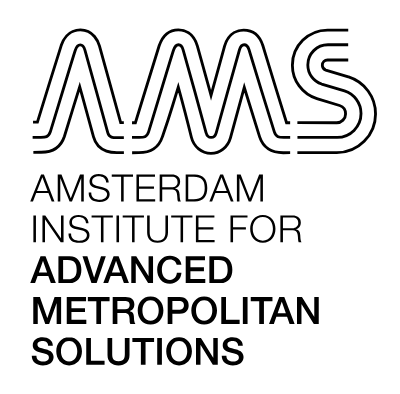
Are you curious for more? Would you like to get in touch? Feel free to contact our lead directly for any questions or inquiries you may have. Tikvah Breimer (MSc MAEd MSc) Director tikvah@studioblended.com +31 6 42 47 29 69
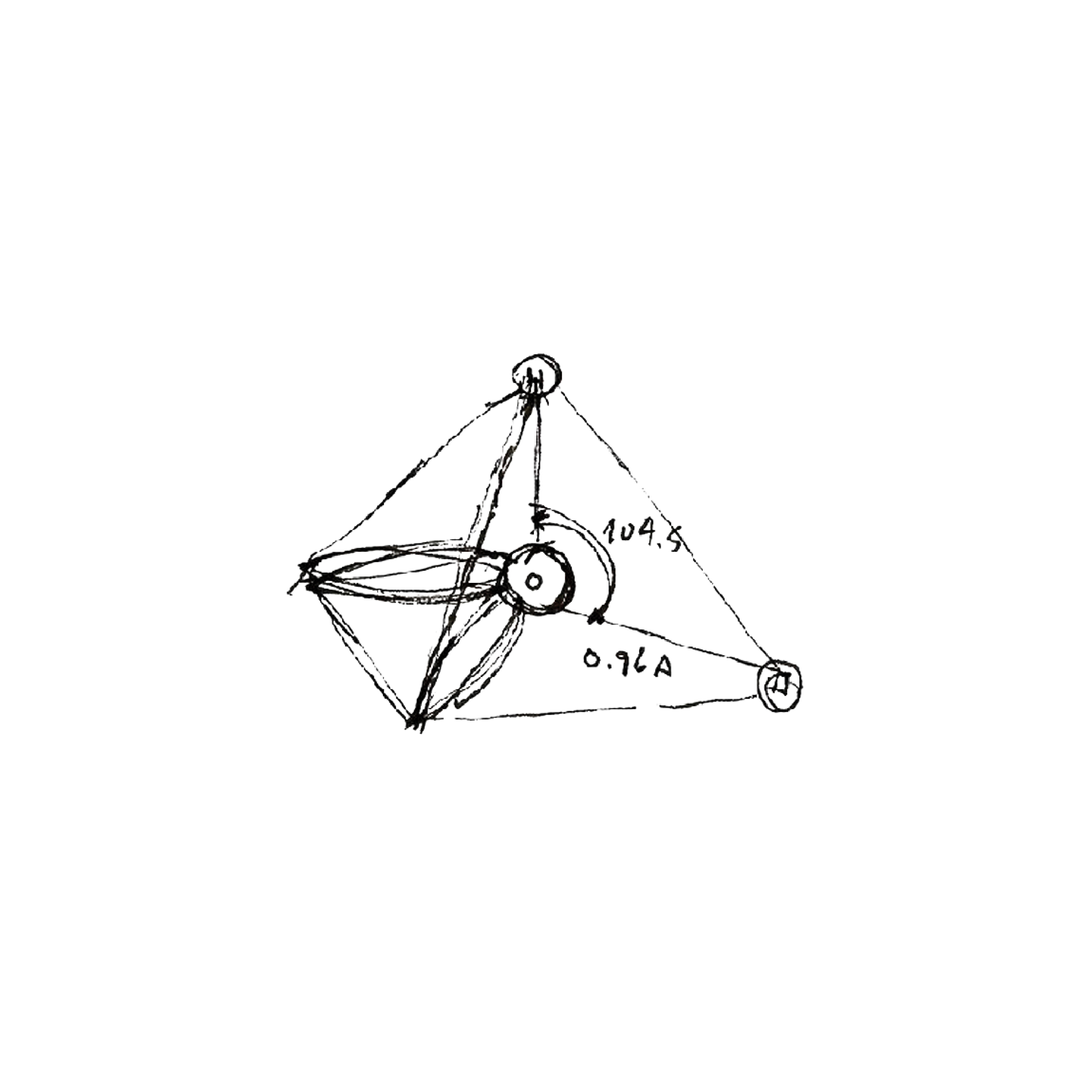
Image: “Architectural Sketch by Cazú Zegers © Cazú Zegers – all rights reserved.”
EDITORIAL: SETTING THE SCENE
© 2026 STUDIOBLENDED https://www.studioblended.com/Technical-resilienceWhen you slow down the initial curriculum design process, you may discover, how by taking a step back, you start to see the long view - and can strategize the scope of your curriculum over time. We need a more strategic approach to the curricula of courses and degrees in Higher Education, one that is smart in the triple constraints of quality, time and cost investment.
Imagine the sheer simplicity, and the smart investment, if you can build upon a curriculum not for 2 years, but for 5, even 10 years? All without losing the organic dynamics that make a curriculum vital.
Slowing down the early stages of the technical curriculum design, is greatly rewarding later on, when concrete timelines and deliverables are set in place for an effective trajectory.
Constructive alignment (Biggs & Tang 2011) is the widely accepted robust design principle for technical curriculum design. It is in the learning objectives/outcomes that STUDIOBLENDED reenvisiones the potential of technical design.
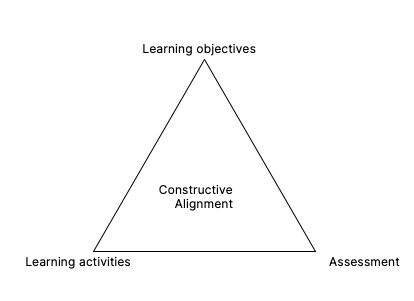 Our technical approach to curriculum design is based on ‘constructive alignment’. You achieve it with backward design, which has proved to be a robust technique for design. Source image: Biggs, J., & Tang, C. (2011). Teaching for Quality Learning at University. Maidenhead, UK: Open University Press.
Our technical approach to curriculum design is based on ‘constructive alignment’. You achieve it with backward design, which has proved to be a robust technique for design. Source image: Biggs, J., & Tang, C. (2011). Teaching for Quality Learning at University. Maidenhead, UK: Open University Press.
We dwell much longer with you on the knowledge domain in your (research) field - and are forward looking: where do you truly envision your field to go in 10 years time?
Thereby, counterintuitively perhaps, our question is not so much where you want your education to go (i.e. a transition you wish to stir), but on the natural course of big ideas in your (academic/practitioners) field, and on making sound choices and decisions about that. We are more antropologically observant so to speak.
What does the natural course of big ideas in your field mean for the scope of the learning journey in your course/degree - for what you’ll focus on (and not)?
How can you strategize the scope of a course or degree in a 10-year window in a paradigm shift?
What does such a scope mean for the workinglife of generations of teachers within your team, over the coming 10 years, and their enjoyment of the work? Is this the right direction for you, and your academic team?
The robust technical design form we use is what we call the ‘fit for purpose framework’ (see below). It is not static, but can be adjusted and rejuvenated dynamically to your research/practice field as required - over time as you roll out your course/training/degree. By combining the frame with modular design, you are equipped to make better decisions on which modules you’d like to develop deeply and which you hold more lightly (see Breimer 2026).
Arriving at a fit for purpose framework for a course/training/degree, requires high over scoping of big ideas in paradigm shifts, coupled with smart scoping of the scope of the learning journey. In that way, we don’t scope everything we possibly find important in the research field, but are dedicated to conclusions: the contours of the course/training/degree.
Where does this design angle come in?
Technical resilience resonates deeply with our vision for resilient education that stands the test of time - by deisgn. The required fit for purpose framework, come in in the early (re)design stages of a course, training or (master)degree.
A good way to scope your knowledge domain is with a workshop ‘big ideas’ or a Design Studio.
THINKPIECE
Why not read our Thinkpiece (2 pager) - forthcoming, to discover more?
FIT FOR PURPOSE (AND OPEN BUILDING)
How then can we, translate the scope of big ideas in a paradigm shift, practically into a technically sound curriculum design?A useful approach comes from land administration and is called fit for purpose. Imagine a cadastre for land administration. A cadastre registers things such as property ownership and plot boundarylines. Time matters. In a very advanced country in land administration, the cadastre will be overall very detailed and cover the entire country. In countries where the cadastre doesn’t exist yet, with this notion of full coverage, it would literally take forever to realise a cadastre. Therefore, in that context, it makes much more sense to create a fit for purpose cadastre: an overarching system that provides an overview in a relatively short time and at relatively low cost, and that is then incrementally filled with the details (see Enemark et al. 2015, 2014, Unger and Bennett 2019). Obviously, the overall fit for purpose framwork must be of the highest quality and deserves all the attention and investment. Otherwise, how will it be resilient and robust well into the future?
The framework allows for ‘open building’ with your education. Open building, introduced in architecture amongst others by John Habraken in the 1960s, enables flexible, renewable building by seperateing the structure (support) from the interior (infill), allowing easy modifications. Integrating this with digitization and automation promotes dynamic, resident-influenced designs and cost-effective costomization.
Likewise, the ‘fit for purpose framework’ can support open building by the teachers, increasing their flexbility and sustainability. The coordinates of the framework, allow for modular education, whilst the infill by teachers is unique per teacher and allows for adaptability, and as long as the overall guidelines remain in tact, the overall course/degree coherence is amplified.
A curriculum needs rejuvination, to ensure it remains a good representation of what an institute is doing, what is happening in the world, and the content growth of the teaching team.
The fit for purpose framework we propose for technical resilience is far from a straightjacket – it is open by nature. It leaves plenty of space for curiosity, wonder, the imagination, inspiration and all that beauty of teaching, equally as giving you a robust ground to stand on and the ability for open building.
By now our fit for purpose framework is simple, and technically perfect - like a pencil.
What is technical perfection?
It means that it keeps its qualities in whatever context.
If you throw it in water, and allow it to dry it can still write.
Should you keep it for a decade, and then try it again: it writes. It is perfect. Which is why it is not further developed, you just see variations of pencils, no difference in the original design.
It is already technically perfect (after Philippe D’Averio).
Likewise, our fit for purpose framework for curriculum design is technically perfect.
OUTPUT: 2-5 PAGER
Find below an example of the output we craft with you, it really is just a 2-5 pager.Realising such a fit for purpose framework, requires dialogue, provocation, co-creation, advise, negotiation, discussion and alignment with all stakeholders. An important challenge is arriving at simplicity together with your teaching team.
Importantly, it is an iterative process. We go from high over big ideas and knowledge domain statements, to the design of the learning objectives of your course or degree, and back to high over again.
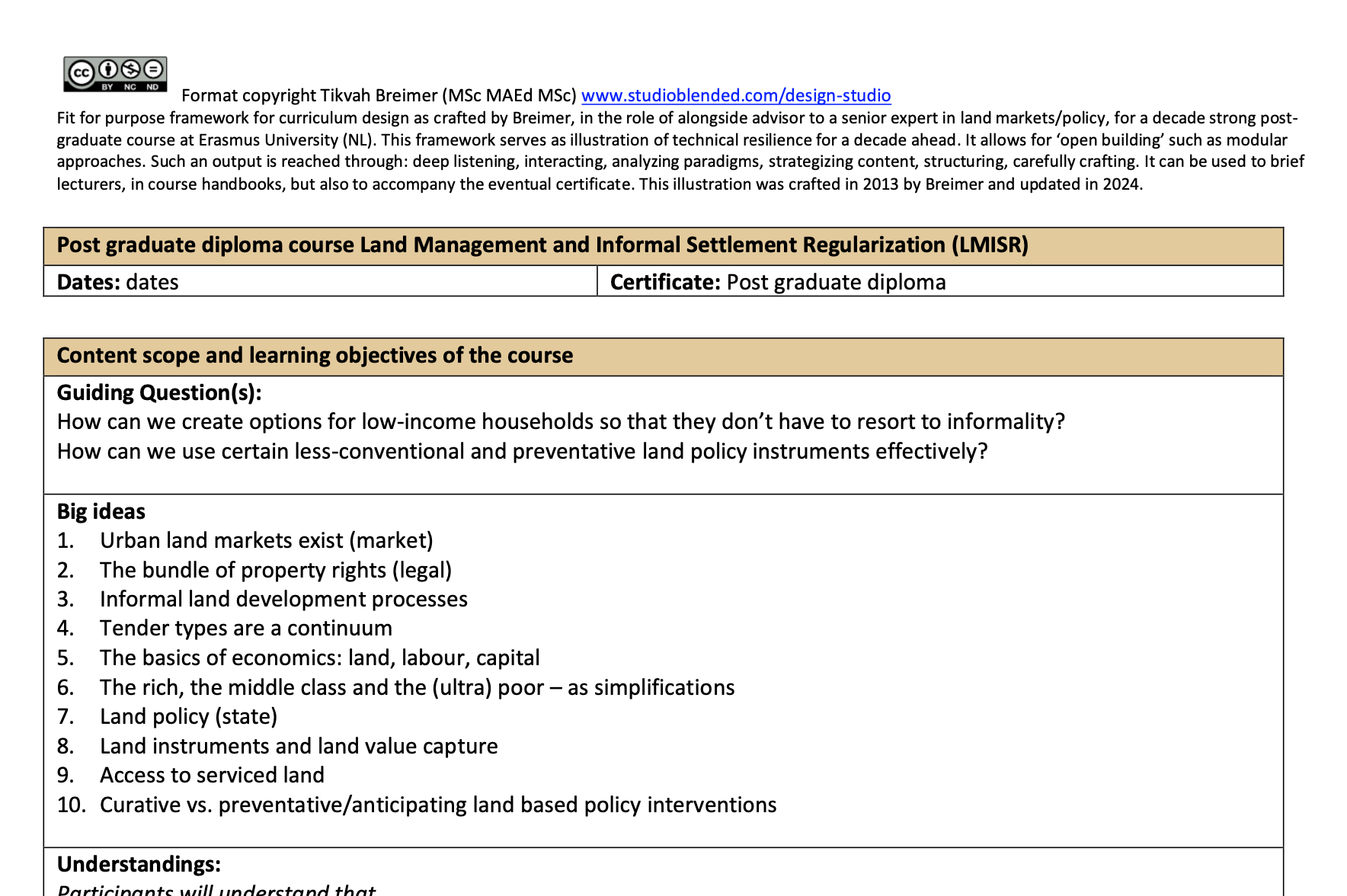
Image: click to expand, and get a full illustration of our ‘fit for purpose‘ framework for technical resilience in your course curriculum. Such a framework allows for ‘open building’ such as with modular approaches to education.
KEY PROJECTS
MASSIVE OPEN ONLINE COURSE (MOOC) funded by the ERC
—
2025 - 2026 (1 year)
—
STUDIOBLENDED is currently working on the realisation of an impactful MOOC for an institute for capacity development within a European University (March 2025 - March 2026).
More information follows soon.


STUDIOBLENDED joined the academic teaching team of MSc Metropolitan Analysis Design and Engineering (MADE) at the Amsterdam Institute for Metropolitan Studies (AMS) to kick-off the new academic year. MSc MADE was founded some 8 years ago. How can it remain relevant and cutting-edge well into the coming years? This is the authentic question of the program director.
Tikvah Breimer (MSc MAEd MSc) delivered a keynote coupled by a group excercise around strategizing and envisioning 'big ideas' in the Master's curriculum - in order to be equipped to simplify and innovate.
The result of the workshop: The teaching team becomes aligned around a shared understanding of the big ideas of the AMS/MADE educational program - and how these evolve over time. The teaching team can take this design forward into futher time-resilient and innovative educational design and development.
“It was inspiring and fruitful [for me as participant]. I realised a course has baseline building blocks versus the trends and hypes that come and go. I realised where to invest in most. I am taking this further for my own field for sure.”
dr. Roberto Rocco
Senior Associate Professor of Spatial Planning and Strategy at TU/Delft Faculty of Architecture and Built Environment, Governance specialist focusing on Spatial Justice and Governance for Just Transitions.
TRAINING AS A PRODUCT WITH AN OPEN BUILDING FRAMEWORK
—
2013 (till 2015, 3,5 years)
—
As early as 2013, the Institute for Housing and Urban Development Studies (IHS) of Erasmus University Rotterdam, was interested in how to approach their capacity development trainings as a product.
Upon invitation by the head of Education, Tikvah Breimer (MSc MAEd MSc) (then staff member) delivers a proposal called ‘Training as a product - A suggestion’.
With open building Tikvah Breimer (MSc MAEd MSc) draws heavily from her Master thesis on open building and incremental housing in architecture (see Erasmus University repository, cum laude).
The proposal includes a strong element of a robust curriculum that stands the test of time - by design, through a technical ‘fit for purpose framework’. It is also completely modular.
The proposal dates back to 2014, but is still decade strong and relevant today, and resonates in all our technical and modular design. It’s simply how we visualise good education.
—
Interested to learn more about technical resilience of the curriculum of your course, degree or program?
Feel free to contact us directly for a free brainstorm session. Tikvah Breimer (MSc MAEd MSc) tikvah@studioblended.com +31 6 42 47 29 69
—
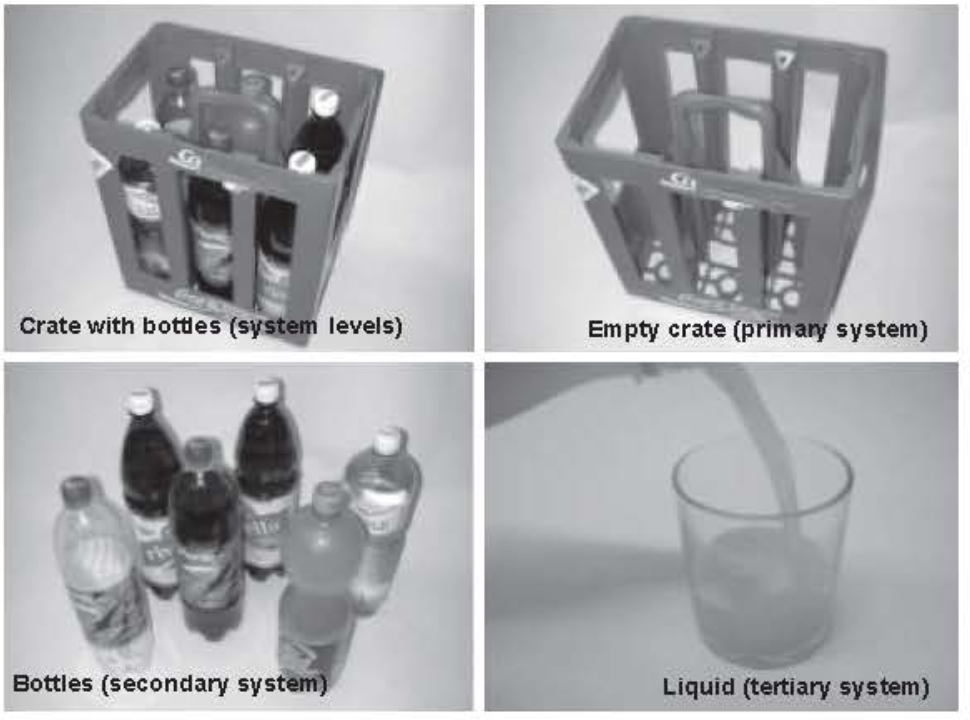 Image: analogy of open building used in proposal to IHS by Tikvah Breimer (MSc MAEd MSc). Visualisation of primary, secondary and tertiary systems within the built (learning) environment. Source: Geiser 2006 in Osman 2010:244.
Image: analogy of open building used in proposal to IHS by Tikvah Breimer (MSc MAEd MSc). Visualisation of primary, secondary and tertiary systems within the built (learning) environment. Source: Geiser 2006 in Osman 2010:244.
—
2013 (till 2015, 3,5 years)
—
As early as 2013, the Institute for Housing and Urban Development Studies (IHS) of Erasmus University Rotterdam, was interested in how to approach their capacity development trainings as a product.
Upon invitation by the head of Education, Tikvah Breimer (MSc MAEd MSc) (then staff member) delivers a proposal called ‘Training as a product - A suggestion’.
With open building Tikvah Breimer (MSc MAEd MSc) draws heavily from her Master thesis on open building and incremental housing in architecture (see Erasmus University repository, cum laude).
The proposal includes a strong element of a robust curriculum that stands the test of time - by design, through a technical ‘fit for purpose framework’. It is also completely modular.
The proposal dates back to 2014, but is still decade strong and relevant today, and resonates in all our technical and modular design. It’s simply how we visualise good education.
—
Interested to learn more about technical resilience of the curriculum of your course, degree or program?
Feel free to contact us directly for a free brainstorm session. Tikvah Breimer (MSc MAEd MSc) tikvah@studioblended.com +31 6 42 47 29 69
—
 Image: analogy of open building used in proposal to IHS by Tikvah Breimer (MSc MAEd MSc). Visualisation of primary, secondary and tertiary systems within the built (learning) environment. Source: Geiser 2006 in Osman 2010:244.
Image: analogy of open building used in proposal to IHS by Tikvah Breimer (MSc MAEd MSc). Visualisation of primary, secondary and tertiary systems within the built (learning) environment. Source: Geiser 2006 in Osman 2010:244.AUDIO PODCAST

🎙 Keynote: Big ideas and modular curriculum design.
Prefer to read? Transcript
Listen on: Acast Spotify Apple
Release summer ‘24
RELATED PUBLICATIONS
Breimer, Tikvah 2026 Resilient education that stands the test of time - by design (forthcoming).Breimer, Tikvah (2011) Open building as an approach for more effective core-housing implementation? An exploration. Masters thesis cum laude in Urban Management and Development, Erasmus University.

Our lead and founder, takes a lively interest in architecture, and made an extensive exploration of the open building approach in architecture (with distinction) at the Institute for Housing and Urban Management (IHS) of Erasmus University Rotterdam.
Breimer, Tikvah (2015). Informal Urban Expansion: Anticipation and Preparation. Workshop Urbanisation in Europe and the World. Joint Research Centre (JRC) of the European Commission in Ispra, Italy, May 28. Discusses the hype cycle of concepts and a paradigm shift in this specific technical (peri)urban field.

Breimer, Tikvah (2014). Preparing for rapid urbanisation in the land market of the peri urban interface (PUI). Archcairo, 6th international conference. The thinkpiece and talk discuss the application of paradigm shifts in this specific technical (peri)urban field.
Breimer, Tikvah (2006). On icaruswings. A new student generation in Nicaragua and the revolutionary ideas of then and today. Master thesis in Anthropology and Sociology of Non-Western societies.
An exploration and theory forming study of subsequent student generations in Nicaragua and their ideas for legitimate democratisation in their own country. It is an in-depth, both through theory on generations and through participatory observations, study of what it means to experience paradigm shifts first hand and how to then understand that at a meta and macro level.
Cum laude. Thesis of the year award, Anthropology and Sociology of Non-Western Countries, University Utrecht, 2006. Available upon request.
OUR FINITE SET OF DESIGN ANGLES
Technical resilienceBig ideas
Paradigm shifts/decade strong
Simplicity and decluttering
Human resilience
Modular
Innovative and deep pedagogy
Assesment / evaluation
Time dimension
Evidence-based design
Financial health and resilience by (re)design
Multi- Inter- and transdisciplinary
Flexibilisation and personalisation
Blended
REFERENCES
Breimer, Tikvah (2026) ‘Resilient education that stands the test of time - by design’ (forthcoming)Enemark, S., McLaren, R., and Lemmen, C. (2015), ‘Fit-For-Purpose Land Administration guiding principles’. United Nations Human Settlements Programme, Nairobi, Kenya Global Land Tool Network (GLTN), Copenhagen, Denmark. Available: https://www.researchgate.net/publication/288503469_Fit-For-Purpose_Land_Administration_Guiding_Principles (Accessed: October 27, 2025).
Enemark, S., Bell, K. C., Lemmen, C. H. J., and McLaren, R. (2014), Fit-For-Purpose Land Administration. Copenhagen: FIG/Worldbank Publication, International Federation of Surveyors (FIG). Available: https://www.fig.net/resources/publications/figpub/pub60/Figpub60.pdf (Accessed: October 27, 2025).
Osman, A. & N. Sebake (2010), ‘“Time” as a key factor in design and technical decision-making: concepts of accessibility, affordability, participation, choice, variety and change in the South African Housing sector’, Human Settlements Review, Vol 1, No 1, pp. 236-252. Available: http://www.dhs.gov.za/Content/Publications/Human%20Settlements%20Review%20Chapters/Human%20Settlements%20Review%20Time%20as%20a%20key%20factor.pdf [accessed September 6, 2011].
Unger, EM. and Bennett, R. (2019), ‘Fit for purpose land administration for all’, Kadaster, April. Available: https://www.kadaster.com/-/fit-for-purpose-land-administration-for-all-1 (Accessed October 27, 2025).
Resilient education that stands the test of time - by design.
Prefer to have direct contact?
Feel free to contact us:
Tikvah Breimer (MSc MAEd MSc)
Independent senior advisor, teacher trainer, director.
tikvah@studioblended.com
+31 6 42 47 29 69
STUDIOBLENDED Non Profit Foundation
Registration Chamber of Commerce
KvK-number 86242598 (Dutch)
VAT identification number
NL 86 39 07 29 5 B01
Bankaccount
NL40 INGB 0709 6156 04
SWIFT/BIC: INGBNL2A
StudioBlended Foundation
Feel free to contact us:
Tikvah Breimer (MSc MAEd MSc)
Independent senior advisor, teacher trainer, director.
tikvah@studioblended.com
+31 6 42 47 29 69
STUDIOBLENDED Non Profit Foundation
Registration Chamber of Commerce
KvK-number 86242598 (Dutch)
VAT identification number
NL 86 39 07 29 5 B01
Bankaccount
NL40 INGB 0709 6156 04
SWIFT/BIC: INGBNL2A
StudioBlended Foundation

